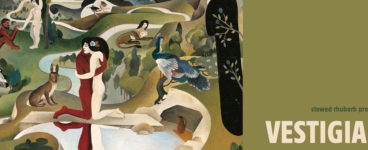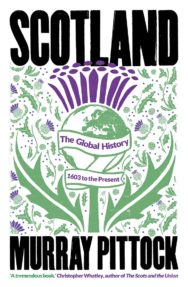‘‘Auld Lang Syne’, now often accounted the second most widely used song globally after ‘Happy Birthday to You’, has a much longer history since it appeared in Robert Burns’ version in 1796.’
Scotland is one of the oldest nations in the world, but to some it is hardly counted as a nation at all. The story of Scotland is one of innovation, exploration, resistance and global consequence, one that Murray Pittock dives into with great detail across its history in his new book. You can read an extract below on Books from Scotland exploring the classic Auld Lang Syne.
Scotland The Global History: 1603 to the Present
By Murray Pittock
Published by Yale University Press
‘Auld Lang Syne’, now often accounted the second most widely used song globally after ‘Happy Birthday to You’, has a much longer history since it appeared in Robert Burns’ version in 1796. Sung in benefit concerts and entr’actes from the beginning of the nineteenth century, it was also inscribed on a snuff box given to George IV on the occasion of the royal visit to Edinburgh in 1822 when the king also enjoyed a ‘gala performance’ of Rob Roy Macgregor, or ‘Auld Lang Syne’.
From 1818 at least, it was sung at Burns Suppers, first appearing in Philadelphia. The radical Andrew White, transported for his part in the 1820 Rising (discussed later in this chapter) referred to it as a New Year song as early as 1822. Used in political discussion in England from the 1817 Pitt dinner and in Continental opera, ballet and drama in the 1820s, by 1850 it had become – like ‘Rule Britannia’ and ‘God Save the Queen’ – a national song, performed on social occasions to express Scottish nationality on British ceremonial and imperial occasions. In the 1830s it was being sung by enslaved people in the Caribbean, and from at least 1852 was being played when British ships left port; by 1864 at the latest it was also used in ceremonies when ‘regiments bade farewell to their old colours’.
Used in the United States by Union troops in the Civil War and during Lincoln’s funeral, and in British politics as a political anthem associated with W.E. Gladstone, it was also the subject of a statue erected in Central Park in the 1860s and provided a reference point in Victorian fiction and popular culture. In 1877, Alexander Graham Bell used it to demonstrate the telephone, and it was one of the first songs recorded for gramophone in 1890. In 1892, the Burns scholar James Dick termed it the ‘most widely diffused song in the civilised world’, and by this period it was regularly being played as a New Year song on both sides of the Atlantic. It subsequently became a song of the Scout movement, and was played at graduations in the US and Asia, where it was played at the British exit from Hong Kong in 1998, and can be heard signifying closing time in Japanese bars and supermarkets.
‘Auld Lang Syne’ is also played at funerals in Taiwan, as well as providing the closing ritual for millions who attend Burns Suppers worldwide, as it has done since at least 1890. Translated into many languages, it even made a brief appearance as the national anthem of the Maldives, as the Burns scholar Morag Grant informs us. Auld Lang Syne’ was popularized as a New Year song for radio by Canadian musician Guy Lombardo at the Roosevelt Hotel in New York from 1929, and later emerged in transmuted form in the hands of Jimi Hendrix, Elvis Presley and Bruce Springsteen among many others.
The song has made repeated appearances in American cinema, most often in a romantic context with a New Year reference – Holiday (1938) is an early example. Such repeated uses in modern culture demonstrate ‘Auld Lang Syne’’s symbolic power, conveying over-whelming sentiment in a language not quite like English, where the characters do not always know what the words ‘even mean’ and some-times say so. (‘Old Long Since’ is not an adequate translation and ‘Old Long Ago’ is not either; nor is it useable English. Scots allows for the use of a double intensifier, and ‘syne’ itself has multiple meanings, which allow the term to have an evocative ambiguity as well as a quality of positive nostalgia unavailable in short English words.) In films such as When Harry Met Sally (1989), Sleepless in Seattle (1993) and Sex and the City (2008) the song has played out as a moment of romantic climax and change, symbolized in the changing of the year.
From It’s a Wonderful Life (1946) onwards it has also been a Christmas song. Less positively, ‘Auld Lang Syne’ has been used to reference the loss of the antebellum South. The Cameron family in D.W. Griffiths’ Birth of a Nation (1915) reflect the core Scottish martial values of bravery, chivalry and openhearted decency trans-planted into a defence of white supremacy in the Confederate states before, during and after the Civil War. The ‘Little Colonel’ Cameron is presented in the film as the chief defender of racial politics against Black rights and miscegenation who keeps the world of ‘Auld Lang Syne’ alive in his bravery and resourcefulness in founding the Klan. The myth of the ‘Celtic South’, argued for in the historian James Michael Hill’s Celtic Warfare (1986) and still widespread today, was deeply reinforced by Griffiths’ film, originally to be titled The Klansman. Convivality, fraternal organizations (Grant argues that the crossing of arms which closes communal singing of the song derives from Masonic practice), social occasions and nostalgia for friends and the happy years spent with them are not always positive emotions, but Burns’ version of this ancient – and in his day Jacobite – Scottish song in praise of a lost past (as all pasts are) is in many respects the signature tune of the Scottish brand.
Scotland The Global History: 1603 to the Present by Murray Pittock is published by Yale University Press, priced £25.
ALSO IN THIS ISSUE

 Vestigial: Nasim Rebecca Asl Interviews Juana Adcock
Vestigial: Nasim Rebecca Asl Interviews Juana Adcock
‘But reading Lanark while going on these lockdown walks…the city looked completely different. I noti …

 Meantime and The Black Dog
Meantime and The Black Dog
‘Closing the book on Meantime and The Black Dog, what we are reminded of is not just the ways in whi …













